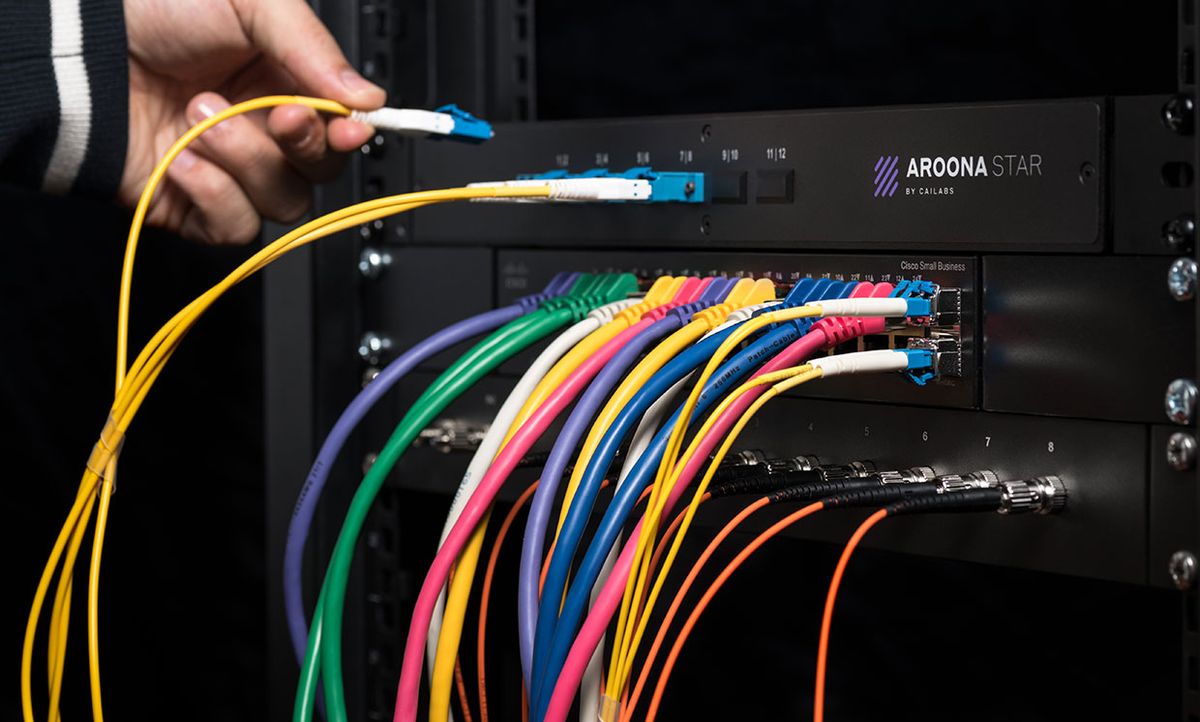Installing optical fibers with fat cores once seemed like a good idea for local-area or campus data networks. It was easier to couple light into such “multimode” fibers than into the tiny cores of high-capacity “singlemode” fibers used for long-haul networks.
The fatter the core, the slower data flows through the fiber, but fiber with 50-micrometer (µm) cores can carry data at rates of 100 megabits per second up to a few hundred meters—good enough for local transmission.
Now Cailabs in Rennes, France has developed special optics that it says can send signals at rates of 10 gigabits per second (Gbps) up to 10 kilometers through the same fiber, avoiding the need to replace legacy multimode fiber. They hope to reach rates of 100 Gbps, which are now widely required for large data centers.
Determining how quickly one can transmit data through an optical fiber depends on the fiber’s core size because the core acts as a waveguide. Long-haul fibers have 9-µm cores, which constrain the 1.55-µm infrared light used in them to a single narrow transmission mode.
Multimode cables with cores of 50 or 62.5 µm allow light to travel in many different modes. However, these modes follow different paths, and thus take slightly different times to pass through the fiber. As a result, the timing of the many pulses spreads out as light travels through the fiber—an effect called modal dispersion that limits the bandwidth of multimode fibers.
In the early days of fiber optics, engineers accepted the limited bandwidth of multimode fibers as a tradeoff because their larger cores greatly reduced the light lost at the many connections in local networks.
Singlemode fiber came into use for long-haul transmission in the 1980s. Carriers needed data rates of hundreds of megabits per second (Mbps) over tens of kilometers, and improvements in splicing and the precision of connectors made singlemode fibers practical over long distances. Today, singlemode fibers can transmit 100 Gbps on up to 100 closely spaced wavelengths, for a total of 10 terabits per second.
Multimode fiber remained the preferred option for local and campus networks because it was cheaper and easier to install wherever many connectors and reconfigurations were needed. Modal dispersion remained tolerable over a couple of kilometers for Ethernet that delivered 100 Mbps.
However, Ethernet transmission with gigabit-per-second speeds requires special conditioning of multimode fiber to reach 550 meters, and Ethernet that delivers 10 Gbps is limited to even shorter distances. That means operators of local-area and campus networks must upgrade their installed networks for GigE or 10-GigE.
In many cases, the obvious choice is to replace the old multimode fiber network with singlemode fiber. That's relatively easy and inexpensive if the old cabling is easily accessible. But as anyone who has ever had to rewire an old house has learned, recabling can be disruptive and downright expensive if it requires heavy construction or threading new cable through twisting paths in existing walls.
Founded in 2013, Cailabs is applying technology it developed to very precisely shape light beams. The technology aims the beam into a fiber so that essentially all the light is captured in one of the many modes the fiber can carry.
"Basically, it's all about launching the right mode into the fiber," says company CEO Jean-François Morizur.
With all the light in one mode, there is no spread in the timing of pulses from modal dispersion, and the multimode fiber can transmit at the much higher data rates of singlemode fiber. "You have to be very precise, so 99.5 percent of the light will be in the right mode, and that's very hard to do," Morizur says.
The company is not giving out details about its process, but telecommunication researchers seeking to achieve ultra-high fiber capacities have transmitted signals in up to six separate modes through fibers with cores of about 20 µm. Each of those modes can transmit at singlemode rates, allowing modal division multiplexing that multiplies the data rate by the number of modes used.
Cailabs has packaged the technology in its Aroona system which can be plugged into existing multimode networks to multiply capacity by a hundredfold. The company has already installed many systems in Europe and a few in the United States at sites including universities, chemical plants, defense bases, refineries, and high schools.
A few weeks ago, Cailabs upgraded a multimode system spanning four kilometers for a major German chemical plant. "Now we are qualified at 10 gigabits [per second] and are testing 100 [Gbps]. You can imagine the savings over recabling in a factory," says Morizur.
The Georgia Institute of Technology had found the costs of replacing cables stretching 400 to 1,100 meters to 35 separate fraternity houses unaffordable, but was able to upgrade the original 100 Mbps capacity to 10 Gbps over a weekend by plugging in the Cailabs modules.
Some 85 to 90 million kilometers of multimode fiber have been installed since 1980, estimates Richard Mack, principal analyst at the CRU Group, a market research firm. Some is not upgradable because it’s built into dedicated links or used in non-networked applications.
Jeff Hecht writes about lasers, optics, fiber optics, electronics, and communications. Trained in engineering and a life senior member of IEEE, he enjoys figuring out how laser, optical, and electronic systems work and explaining their applications and challenges. At the moment, he’s exploring the challenges of integrating lidars, cameras, and other sensing systems with artificial intelligence in self-driving cars. He has chronicled the histories of laser weapons and fiber-optic communications and written tutorial books on lasers and fiber optics.



